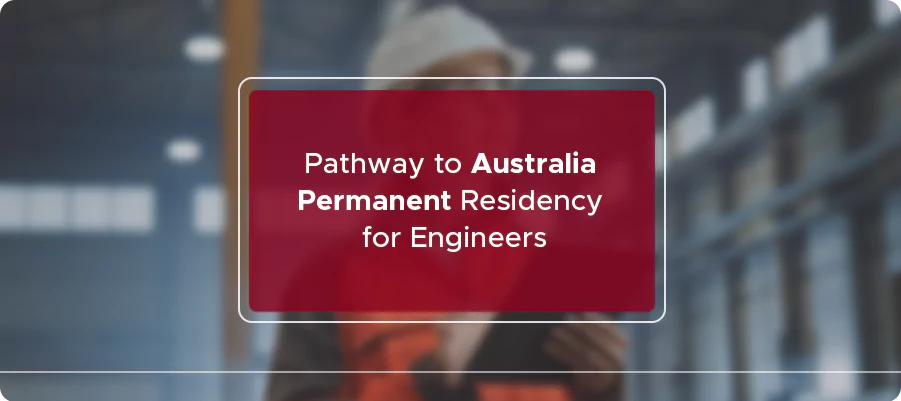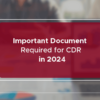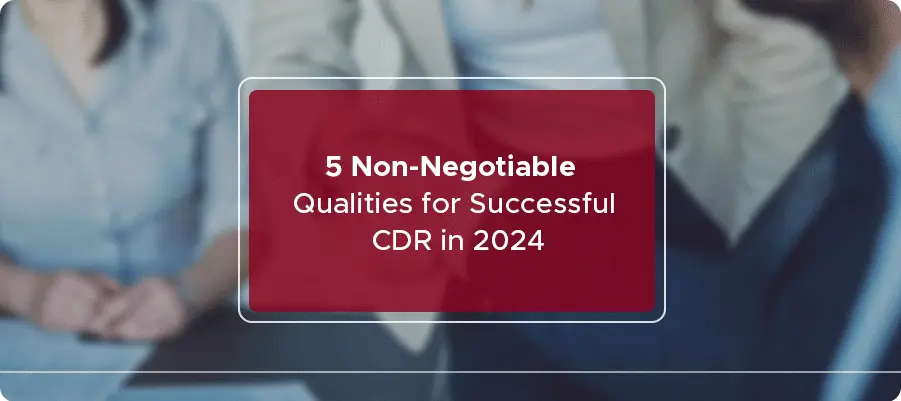
Easy Pathway to Australian Permanent Residency for Engineers
The pathway to Australian permanent residency for engineers involves sophisticated steps and requirements. Australia offers a range of visa options for skilled professionals, including engineers, who are looking to migrate to the country permanently.
Holding an Australian permanent residency as an engineer offers several benefits, such as the ability to live and work in Australia permanently, access to public services, the freedom to travel in and out of the country, and the ability to sponsor family members to join. Permanent residency for Engineers status provides security and opens up new opportunities in Australia.
The specific requirements and steps in obtaining Permanent Residency(PR) in Australia vary based on the visa category you apply for. Some of the most popular visa categories for engineers include the Skilled Independent Visa (Subclass 189), the Skilled Nominated Visa (Subclass 190), Employer Nomination Scheme Visa (Subclass 186).
Pathway to Australia Permanent Residency for Engineers
Here is an overview of the steps in obtaining Australian permanent residency for engineers.

Step 1: Select the Appropriate Visa Type
Before beginning the process of obtaining a permanent visa for engineers in Australia, selecting the appropriate visa type is essential based on your circumstances and goals.
As mentioned earlier, the most popular permanent visas for skilled professionals, including engineers, are the Skilled Independent Visa (Subclass 189), the Skilled Nominated Visa (Subclass 190), and the Employer Nomination Scheme (Subclass 186). Each visa has different eligibility criteria, requirements, and advantages, so it is essential to consider your situation and determine which visa is best for you.
Step 2: Determine Eligibility
The second step in obtaining a permanent visa for engineers in Australia is determining your eligibility. The eligibility criteria for permanent residency for Engineers visas vary based on the specific visa category. To be eligible for these visas, you must meet the following general requirements:
- Age: You must be under 45 at the time of application.
- English language proficiency: You must meet the minimum English language requirement of the Department of Home Affairs.
- Skill Assessment: You must have your engineering qualifications assessed by the relevant Australian assessing authority.
- Points-based System: You must score at least 65 points on the points-based system. Points are awarded based on factors such as age, education, work experience, and English language proficiency.
Step 3: Submit an Expression of Interest (EOI)
Once you have determined your eligibility, the next step is to submit an Expression of Interest (EOI) through the SkillSelect system. This online system allows you to express your interest in migrating to Australia as a skilled worker. In your EOI, you will provide information on your qualifications, work experience, and other relevant details.
Step 4: Receive an Invitation to Apply
If your EOI is successful, you will receive an invitation to apply for a permanent visa. The invitation will be valid for 60 days, during which time you must submit a complete visa application.
Step 5: Submit a Visa Application
To apply for a permanent residency for engineers in Australia, you must complete a comprehensive visa application and provide various supporting documents. Some of the documents you may need to provide include the following:
- Passport and other identification documents
- Proof of English language proficiency
- Skill Assessment certificate
- Work references and employment records
- Educational qualifications
- Police clearance certificates
- Medical examination certificates
- Character references
Learn More: The Four Occupational Categories in Engineering Recognized by EA ⏱⌛️
Step 6: Pay the Visa Application Fee
Once your visa application is complete, you will need to pay the visa application fee. The fee for permanent visas varies based on the visa category and other factors.
Step 7: Wait for a Decision
Once your visa application is submitted, you must wait for a decision. The processing time for permanent visas can vary, but you can expect to wait several months for a decision to be made.
Step 8: Prepare for Arrival in Australia
If your visa application is approved, you will be granted a permanent visa and can live and work in Australia as a permanent resident. Before you arrive in Australia, it is important to prepare for your new life by researching the local area, finding accommodation, and arranging for the transportation of your belongings.
Skilled Visas Points for Engineers
The points for skilled visas in Australia are determined based on several factors, including.
- Age: Points are awarded based on the applicant’s age, with the highest points awarded to those aged 25-32.
- Educational Qualifications: Points are awarded for having a relevant degree or higher educational qualification in the nominated occupation or a closely related field.
Professional Year Program: Points are awarded for completing a Professional Year Program in Australia. - NAATI- Credentialed Community Language: Points are awarded for demonstrating proficiency in an Australian community language, as assessed by NAATI (National Accreditation Authority for Translators and Interpreters).
- 2-Year Study: Points are awarded for completing at least 2 academic years of full-time study in a relevant field in Australia.
- English Language Ability: Points are awarded for the applicant’s English language proficiency, as assessed by an approved English language test.
- Regional Study: Points are awarded for completing a relevant qualification in Australia’s regional or low-population growth metropolitan area.
- Work Experience: Points are awarded for the applicant’s relevant work experience in Australia and overseas.
- Specialist Educational Qualifications (STEM): Points are awarded for having a relevant STEM (Science, Technology, Engineering, Mathematics) qualification.
- Partner: Points may be awarded for having a partner who can also meet the eligibility criteria for the visa.
These points are used to determine eligibility for various skilled visas, such as the Subclass 189 Skilled Independent Visa, the Subclass 190 Skilled Nominated Visa, the Subclass 491 Skilled Work Regional (Provisional) Visa, and the Subclass 494 Skilled Employer Sponsored Regional (Provisional) Visa, among others. The minimum points required for each visa can vary but usually range from 65 to 90 points.
Learn More: Australian Visa Options for Qualified Electrical Engineers 🧑🏽✈️🏆
Potential Australian PR Visas for Engineers
Engineers in Australia can apply for several potential PR visas, as many engineering occupations are on the Medium and Long-Term Strategic Skills List (MLTSSL). These visas include:
Subclass 189 – Skilled Independent Visa
This visa allows for permanent residency in Australia and is a points-tested visa. The minimum score required to receive an invitation for this visa is 90.
Subclass 190 – Skilled Nominated Visa
Like Subclass 189, this visa allows for permanent residency for Engineers in Australia and is a points-tested visa. To be eligible to apply, a minimum of 65 points is required, and the applicant must have a state willing to nominate them.
Subclass 491 – Skilled Work Regional (Provisional) Visa
This visa is not permanent but can lead to a permanent visa (Subclass 191 – Skilled Regional Visa). It allows the applicant to live, work, and study in a designated regional area of Australia and is a points-tested visa, with a minimum of 65 points required. The applicant must be nominated by a state or sponsored by an eligible relative.
Subclass 494 – Skilled Employer Sponsored Regional (Provisional) Visa
This visa requires an employer to sponsor the applicant, who must also have at least 3 years of working experience in their nominated occupation and a relevant skills assessment. The applicant must work for the sponsoring employer.
Learn More: Skilled Employer Sponsored Regional Visa (Subclass 494) 📖📖
Subclass 191 – Permanent Residence Skilled Regional Visa
This visa allows for permanent residency for Engineers in Australia. It is for individuals who hold a Subclass 491 or 494 visa and have lived, worked, or studied in a designated regional area for at least 3 years with a taxable income of at least $53,900.
Subclass 186 – Employer Nomination Scheme Visa
This permanent residency visa requires an employer to sponsor the applicant, who must also have at least 3 years of working experience in their nominated occupation and a positive skills assessment. Alternatively, individuals with a Subclass 457 or TSS visa can apply after working for their employer for at least 3 years.
Guaranteed Positive Skills Assessment!
Get High-Quality CDR at an Affordable Price
Engineers Australia Skills Assessment Pathways
Qualification Accredited by Engineers Australia (Accord)
EA accredits some courses in Australia and overseas. These courses have previously been assessed as meeting the educational requirements for becoming a professional engineer in Australia. Most approved courses are taught in Australia, while some are taught abroad, such as in Malaysia or Singapore. When applying for a skills assessment, select the Australian Qualification Pathway if you have successfully completed an accredited course. The full list of accredited courses can be found on their website.
| Pathway | Description |
| Washington Accord | Recognises accredited qualifications by other signatories of the Washington Accord, including countries like China, India, Korea, Malaysia, Russia, Sri Lanka, and others. The qualification must be equivalent to an Australian 4-year Bachelor’s degree. |
| Sydney Accord | Recognises accredited qualifications by other signatories of the Sydney Accord, including countries like Canada, Hong Kong, Ireland, Malaysia, New Zealand, South Africa, Taiwan, the UK, the USA, and others. The minimum academic requirement is a 3-year Bachelor of Technology degree in engineering. |
| Dublin Accord | Recognises accredited qualifications issued by signatories of the Dublin Accord. The full list of signatories can be found on the Engineers Australia website. |
Non-accredited Qualification (Non-Accord)
You must apply for a skill assessment under the CDR pathway. If none of the above applies, you must apply for a skill assessment under the Competency Demonstration Report (CDR) pathway.
| Pathway | Description |
| Competency Demonstration Report (CDR) | For non-accredited or non-Accord qualifications, you must prepare a report including Continuing Professional Development, 3 Career Episodes, and a Summary Statement to demonstrate your engineering competency. |
Learn More: Pathways for Migration Skills Assessment ✏️✏️
Conclusion
Obtaining Australian permanent residency for engineers can be a complex process, but with the right preparation and support, it can be a rewarding experience. Suppose you are considering migrating to Australia as an engineer. In that case, it is important to seek the advice of a migration agent or immigration lawyer who can help guide you through the process and ensure that your application is as strong as possible.
You might have to prepare CDR to collect extra PR points if you are an engineer. CDRReportWriters is established as one of the top CDR service providers, helping engineers worldwide apply for and pursue an engineering career in Australia. We propose the best CDR writing service. Our writing experts are highly skilled and can direct you with the essential compliance of Australian immigration. We prepare CDR for almost all engineering domains within the guidelines of Engineers Australia and can guarantee that you will receive 100% approval from the EA.





